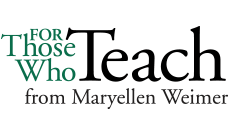There’s a new book out called Activating a Teaching-Learning Philosophy. The word “activating” caught my attention. To me that says “doing something about your teaching-learning philosophy.” Unfortunately, our current use of teaching philosophy statements doesn’t usually contain that expectation. Most often faculty prepare these statements as part of job applications, promotion and tenure processes, or for permanent contract positions. Their use for these purposes diminishes their value in several ways. There’s strong motivation to construct the philosophy statement that anticipates what the reviewers want to read, as opposed to one that reflects actual belief. And, there’s not much danger of being held accountable for what’s in the statement. So generally, teaching philosophy statements end up in a file where they don’t have much impact on teaching or learning.

And that’s really too bad because there’s a great deal a teacher can learn from preparing and activating a teaching philosophy. Every teacher should have mindfully considered the beliefs and values that are at the heart of what they do. Equally significant is the relationship between what the teacher believes and the teaching that occurs in the courses.
At the beginning of a career, most of us don’t think much about the philosophy that guides our teaching. There are courses to prep and a myriad of instructional details that demand attention. But at some point, most of us do start thinking about what we’re doing and whether it jives with what we believe. I love this description of that process offered by a group of graduate students (Bauer et al.) taking a course intended to prepare them to teach. They report having a hodge-podge of ideas and teaching preferences, but not a coherent teaching philosophy. “To borrow a metaphor from Frankenstein, it was as if we laid out our collection of body parts on the table and found, given the missing limbs and duplicate livers, that they didn’t quite make up a whole teacher—certainly not one we’d want to take a class from” (p. 182).
The metaphor opens a back door into what happens when we start, not with the philosophy, but by analyzing our collection of teaching policies and practices. What do the strategies we rely on, the activities and assignments we use, and our approaches to assessment and feedback say about what we believe? That analysis might reveal practices that don’t fit together in a terribly consistent way. Or, it could be that how we teach does come together as a philosophy, but not one that very accurately represents our beliefs.
The new book mentioned above recommends we go in through the front door—that we start by generating the philosophy, those bedrock beliefs that provide the larger framework within which we hope to operate. Then with philosophy in hand, the task is figuring out how those beliefs can be implemented with a set of policies and practices that fit within that belief framework, and that’s not an easy task. Say you believe in second chances for learners, that students should be able to make mistakes, and learn and recover from them. What kind of policy supports that belief? Is it one that allows for extra credit, offers chances to re-do assignments, or drops the lowest score? Perspective provided by a trusted colleague can be especially helpful at this juncture.
The value of constructing your teaching-learning philosophy and laying out what it would look like in practice comes when it’s compared with the set of policies and practices actually being used. It makes those disconnects between beliefs and behaviors more obvious. For example, you may believe that students are responsible for learning and yet teach in ways that prevent students from making any decisions about what or how they learn.
Whether you start with your teaching and the philosophy your instructional practice defines, or you start with what you believe and then create the policies and practices that activate it, you end up with a process that can’t help but be enlightening. And that’s what we should be doing with teaching-learning philosophies.
References
Grise-Owens, E., Miller, J., & Owens, L. W. (2018). Activating a teaching-learning philosophy: A practical guide for educators. Alexandria, VA: Council on Social Work Education Press.
Beatty, J. E., Leigh, J., & Dean, K. L. (2009). Philosophy rediscovered: Exploring the connections between teaching philosophies, educational philosophies and philosophy. Journal of Management Education, 33(1), 99–114.
Bauer, D., et al. (2007). Forging a pedagogical community. Pedagogy, 8(1), 179–193.







One Response
Phil Titus and I (Dwayne Gremler) tackled this issue in a 2010 article in the Journal of Marketing Education. Here is the citation:
Titus, Philip A. and Dwayne D. Gremler (2010), “Guiding Reflective Practice: An Auditing Framework to Assess Teaching Philosophy and Style,” Journal of Marketing Education, 32 (2), 182-196.